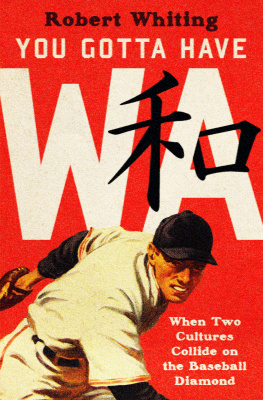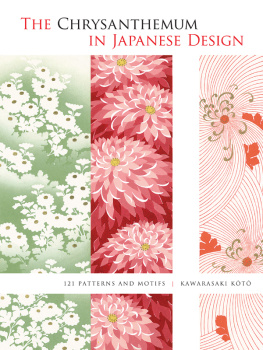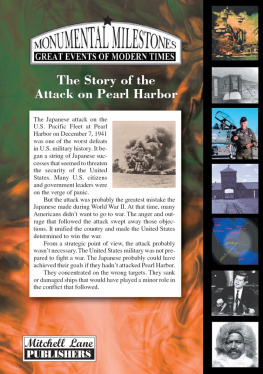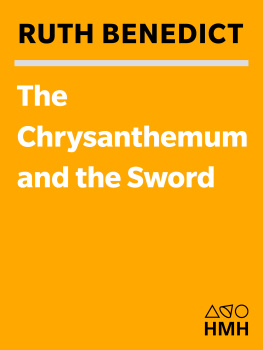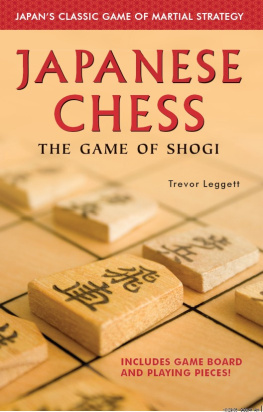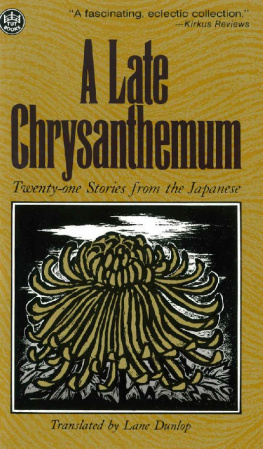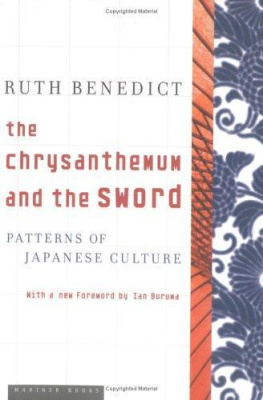Robert Whiting - The Chrysanthemum and the Bat: The Game Japanese Play
Here you can read online Robert Whiting - The Chrysanthemum and the Bat: The Game Japanese Play full text of the book (entire story) in english for free. Download pdf and epub, get meaning, cover and reviews about this ebook. year: 2014, publisher: Japanime Co. Ltd., genre: Home and family. Description of the work, (preface) as well as reviews are available. Best literature library LitArk.com created for fans of good reading and offers a wide selection of genres:
Romance novel
Science fiction
Adventure
Detective
Science
History
Home and family
Prose
Art
Politics
Computer
Non-fiction
Religion
Business
Children
Humor
Choose a favorite category and find really read worthwhile books. Enjoy immersion in the world of imagination, feel the emotions of the characters or learn something new for yourself, make an fascinating discovery.

- Book:The Chrysanthemum and the Bat: The Game Japanese Play
- Author:
- Publisher:Japanime Co. Ltd.
- Genre:
- Year:2014
- Rating:5 / 5
- Favourites:Add to favourites
- Your mark:
- 100
- 1
- 2
- 3
- 4
- 5
The Chrysanthemum and the Bat: The Game Japanese Play: summary, description and annotation
We offer to read an annotation, description, summary or preface (depends on what the author of the book "The Chrysanthemum and the Bat: The Game Japanese Play" wrote himself). If you haven't found the necessary information about the book — write in the comments, we will try to find it.
The Chrysanthemum and the Bat: The Game Japanese Play — read online for free the complete book (whole text) full work
Below is the text of the book, divided by pages. System saving the place of the last page read, allows you to conveniently read the book "The Chrysanthemum and the Bat: The Game Japanese Play" online for free, without having to search again every time where you left off. Put a bookmark, and you can go to the page where you finished reading at any time.
Font size:
Interval:
Bookmark:
Dedicated to
Clete Boyer and Sadaharu Oh
Foreword
This is a book about the Japanese people. It is a look at their culture through a game they dearly lovethe game of baseball.
At first glance, baseball in Japan appears to be the same as the U.S. versionbut it isn't. The Japanese view of life, stressing group identity, cooperation, hard work, respect for age and seniority, and "face" has permeated nearly every aspect of the sport, giving it a distinct character of its own. American players who come to Japan quickly realize they have entered a different world. For some, it is fascinating and exciting; for others, exasperating and occasionally devastating.
Baseball seemed to me the ideal framework from which to approach Japan. It is a business, a game, and a spectator sport; a cross-cultural common denominator to which people can relate emotionally as well as intellectually. A study of the way the game has been modified to accommodate Japanese social values, emphasizes the many differences between East and West.
Names and statistics keep changing. This book is not intended to be a comprehensive record of individual accomplishments. Rather, it focuses on the cultural pressures that shape individual attitudes and performance.
I have attempted to present an objective picture of Japan. If at times I seem critical, it does not diminish the affection and abiding respect I have for the Japanese. They have given me another way to look at my fellow man.
Robert Whiting
Tokyo, 1977
Acknowledgements
I would like to thank the following for their help in putting this book together: Hiroshi Akimoto, correspondent, Tokyo Chunichi Sports ; George Altman, former infielder, Hanshin Tigers; Toshiro Ashiki, Public Relations Director, Chunichi Dragons; Kaoru Betto; Clete Boyer, Coach, Taiyo Whales; Shinichi Eto, outfielder, Lotte Orions; Hiroshi Gondo, Coach, Chunichi Dragons; Norio Hattori, Baseball Magazine ; Ikuo Ikeda, Director, Baseball Magazine ; Hideyuki Inubushii; Shigeo Ishida, Writer, Nikkan Sports ; Kazuo "Pancho" Ito, Public Relations Director, Pacific League Office; Dave Johnson, infielder, Yomiuri Giants; Takeaki Kaneda, Asian Director, Sports Illustrated ; Noboru Kawai, Publishing Department, Hochi Shimbun ; Koichi and Machiko Kawamura; Tadasu Kimura, M.D.; Sadao Kondo, Head Coach, Chunichi Dragons; Jim Lefebvre, infielder, Lotte Orions; Joe Lutz, former Manager, Hiroshima Carp; Tsuyoshi Miyakawa, AIPS Acting Vice-President, Kyodo News Service ; Nariyashu Morishita, Rikio Murano, and Toshio Naka, Coaches, Chunichi Dragons; Hiroo Nakao, President, Grolier International (Japan); Leslie Nakashima, Sports Editor, UPI Asia; Masanori Ochi, Sports Director Nippon TV; Dave Roberts, former infielder, Yakult Atoms; Toshiyaki Sakai; Tokyo Chunichi Sports; John Sipin, infielder, Taiyo Whales; Daryl Spencer, former infielder, Hankyu Braves and presently Manager, Coors baseball team; Takejuh Suzuki, writer and Professor, Meiji University; Toshiro Suzuki; Naokazu Tsukada, Trainer, Chunichi Dragons; Tadahiro Ushigome, Public Relations Department, Taiyo Whales; Wally Yonamine, Manager, Chunichi Dragons, and his wife, Jane.
I would also like to give special thanks to Machiko Kondo for her help in translations from Japanese and in the typing of the manuscript; to Dale Miller for his help in the revisions of the original draft; and finally, to Dwight Spenser, who, more than anyone else, is responsible for the existence of this book. To him, I owe a special debt of gratitude.
Chapter 1
Outdoor Kabuki
The big Seiko clock above the electronic scoreboard in center field read 6:20thirty minutes before game time. The two-tiered 50,000 seat Korakuen Stadium was already filled to overflowing. In the special jumbo stands down the left and right field foul lines, policemen were urging standing-room ticketholders to move a little closer together so that even more people could be packed in to see the game.
The sushi , sake , and hotto doggu vendors had sold out their first loads and were hurrying back for refills before the aisles became completely clogged with fans.
Behind both dugouts, camera crews from two major networks were setting up their equipment to televise the game. In the press box, sportswriters from Japans five major sports dailies were getting ready to report the evenings contest.
As a soft female voice announced the starting pitchers, the ticket windows outside the massive stadium closed, causing hundreds of irate fans to storm the gate. One old man was trampled in the rush and carted off to the hospital.
The event was a game between the two teams tied for first place in the Central Leaguethe Yomiuri Giants of Tokyo and their traditional rivals from Osaka, the Hanshin Tigers. It was the first day of June and the season was only seven weeks old.
Each spring when the cherry blossoms come into bloom, the Land of the Rising Sun starts its annual love affair with the game of baseball. Almost overnight, Japan is transformed into a nation of starry-eyed pitchers, catchers, and home run hitters; a nation of bsubru nuts.
White-collar workers grab the company ball and bat at lunchtime and head to the nearest park for a quick game of work-ups under the noonday sun. Delivery boys park their motorcycles between noodle deliveries and pull fielders gloves from back pockets for a leisurely game of catch-ball in the nearest alley.
Platform conductors in train stations practice shadow swings with their red signal flags or work on their pitching deliveries with discarded candy wrappers, while those with enough time throng to the nearest batting range for 100 yen worth of swings against a mechanical curve-ball pitcher. And all across the nation thousands of diamonds are filled with aspiring sluggers, ready to fight it out for the prestige of wearing that school uniform. Each season, millions of fans pour through the turnstiles to see their favorite teams in actionfrom the little leagues all the way up to the professionals. The sport is so popular that even high school and college games draw capacity crowds.
The annual ten-day national high school championship tournament at Koshien Stadium in Osaka draws over 400,000 and is, in Japan, an event equal in significance to the Stanley Cup playoffs in hockey or the World Cup finals in soccer. There is hardly a TV set in any house, coffee shop, or tearoom around the nation that is not turned on to NHK (Japans government owned national TV network) to see the continuous nine-to-six live daily coverage of the tournament.
College teams, such as those in Tokyos glamorous Big Six University League, are followed with the fervor that Americans usually reserve for Saturday afternoon collegiate football. The semiannual three-game series between Tokyos traditional crosstown rivals, Keio and Waseda, for example, draws well over 60,000 spectators per match and commands a nationwide TV audience. For sheer spectacle, this event outdoes a Michigan-Ohio State football game. Karate-chopping cheerleaders and raven-haired pom-pom girls lead a stadium full of frenzied students wildly screaming ganbare (Lets go) in unison. A series win for Waseda touches off a wild night of merrymaking in the narrow twisting sidestreets of Shinjuku (Tokyos version of Greenwich Village) that is reminiscent of Times Square on New Years Eve. A Keio win brings a similar fate to the downtown area of the Ginza.
The national obsession with yaky (field ball), as it is commonly known, hits its peak when the glamor boys of Nipponthe professionalstake the field. Each year, nearly twelve million bsubru fanatics turn out to watch the twelve teams of Japans two professional leagues, the Central and the Pacific. While two and a half millionor one out of every four spectatorsflock to Korakuen Stadium to see the darlings of Japan, the Yomiuri Giantsthe oldest, winningest, and most popular team in the country.
Next pageFont size:
Interval:
Bookmark:
Similar books «The Chrysanthemum and the Bat: The Game Japanese Play»
Look at similar books to The Chrysanthemum and the Bat: The Game Japanese Play. We have selected literature similar in name and meaning in the hope of providing readers with more options to find new, interesting, not yet read works.
Discussion, reviews of the book The Chrysanthemum and the Bat: The Game Japanese Play and just readers' own opinions. Leave your comments, write what you think about the work, its meaning or the main characters. Specify what exactly you liked and what you didn't like, and why you think so.

